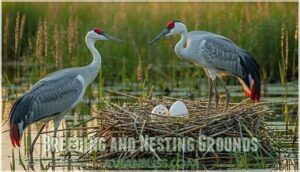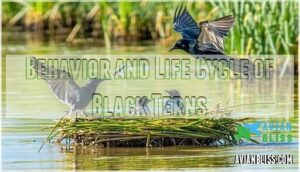This site is supported by our readers. We may earn a commission, at no cost to you, if you purchase through links.
 Black terns are easy to spot during breeding season with their distinctive jet-black head and underparts that contrast beautifully against silvery-gray wings.
Black terns are easy to spot during breeding season with their distinctive jet-black head and underparts that contrast beautifully against silvery-gray wings.
These compact marsh birds clock in at 9-10 inches long with 24-inch wingspans, and they’re absolute acrobats in the air over freshwater wetlands.
They’re found across North America’s shallow marshes, building floating nests just above water surfaces. Black terns hunt insects like dragonflies and midges using surface-skimming techniques, serving as key indicator species for wetland health.
Unfortunately, their populations have crashed since the 1960s due to habitat loss, earning them threatened status in several states. Their striking migration patterns and specialized feeding behaviors reveal fascinating adaptations.
Table Of Contents
- Key Takeaways
- Black Tern Appearance and Identification
- Habitat and Range of Black Terns
- Behavior and Life Cycle of Black Terns
- Diet and Ecological Role
- Conservation Status and Protection Efforts
- Frequently Asked Questions (FAQs)
- What does a black tern look like?
- What does a black tern do?
- What are some interesting facts about black terns?
- Are black terns a real bird?
- How many black terns are there?
- Where do black terns breed?
- Are black terns rare?
- Where do black terns live?
- Why is the Black Tern endangered?
- How many black terns are left?
- Conclusion
Key Takeaways
- You’ll recognize black terns by their jet-black head and underparts during breeding season, contrasting with silvery-gray wings, making them easy to spot in freshwater marshes.
- You can find these acrobatic birds in shallow wetlands across North America, where they build floating nests and perform butterfly-like flight patterns while hunting insects.
- You’re witnessing a conservation crisis—black tern populations have crashed since the 1960s due to wetland drainage, earning them threatened status in several states.
- You can help by supporting wetland restoration projects and reducing pesticide use, since these birds serve as key indicators of ecosystem health.
Black Tern Appearance and Identification
You’ll recognize a Black Tern by its distinctive breeding plumage featuring a jet-black head and underparts contrasted against silvery-gray wings and back.
This robin-sized waterbird measures 9-10 inches long with a wingspan of about 24 inches and displays remarkably acrobatic flight patterns as it swoops low over marshes and wetlands.
Size, Build, and Measurements
Spotting a Black Tern is pretty straightforward once you know what to look for. These compact little birds have a sleek build that sets them apart from other terns you might see around marshes and wetlands.
Size-wise, they’re on the smaller end – about 9 to 14 inches long with wings that span roughly 22 to 24 inches. They’re surprisingly light too, weighing in at just under 2 ounces. Think of them as the lightweight athletes of the tern world.
What really catches your eye are their key features:
- A thin, needle-sharp bill that’s perfect for snatching insects and small fish
- Long, slender wings built for quick turns and agile flight
- Stubby legs that work well for perching on marsh vegetation
- Thick, waterproof feathers that keep them dry during their wetland lifestyle
One thing that makes field identification easier? Both males and females are basically identical in size, so you don’t have to worry about telling them apart based on their build alone.
Breeding Vs. Non-breeding Plumage
Size isn’t everything when it comes to identifying Black Terns – it’s all about those striking plumage changes throughout the year.
In breeding season, these birds are unmistakable with their jet-black heads and bellies set against silvery-gray wings. Come fall and winter, they flip the script completely. That dramatic black gets swapped out for crisp white, leaving just a telltale dark smudge behind the eye.
Once you learn these seasonal switches, spotting Black Terns becomes pretty straightforward.
Beyond their compact size, Black Tern identification hinges on dramatic plumage patterns that shift with seasons. During breeding season, you’ll spot their signature jet-black head and underparts contrasting sharply with silvery-gray wings. Non-breeding plumage transforms them completely – white underparts and head replace the black, with just a small dark patch behind the eye. These color changes follow predictable molt cycles, making Black Tern identification straightforward once you understand their feather development patterns.
| Feature | Breeding Plumage | Non-breeding Plumage |
|---|---|---|
| Head | Deep black | White with dark ear patch |
| Underparts | Black throughout | Clean white |
| Wings | Silvery-gray | Gray with darker tips |
| Back | Charcoal gray | Light gray |
| Bill | Dark with slight curve | Blackish, pointed |
Distinguishing Features From Similar Species
You’ll spot Black Terns easily once you know their key features. Their beak shape is thin and pointed, unlike the stouter bill of White-winged Black Tern. Bill length measures about 25mm—shorter than Common or Forster’s Terns.
Head color stays uniformly black in breeding plumage, while wing tips appear gray without white patches. These tern physical characteristics separate them from similar species like Least Tern.
Observing the leg color differences can also aid in identifying Black Terns from other tern species.
Flight Characteristics and Vocalizations
You’ll spot Black Terns by their unique flight style – they move in erratic, bouncy patterns that look almost like butterflies dancing over water. These birds beat their wings quickly while following direct but wavy flight paths.
What makes them such skilled fliers? Their pointed wings and deeply forked tails work together like built-in flight controls, letting them pull off impressive aerial stunts.
Listen for their distinctive calls too – sharp metallic "kik" sounds mixed with softer "kyew" notes, especially when they’re traveling their migration routes through wetland areas.
Black Tern vocalizations consist of harsh metallic "kik" bird calls and softer "kyew" sounds during Migration Routes across wetlands.
Habitat and Range of Black Terns
You’ll find black terns in freshwater marshes and wetlands across North America, from southern Canada to the northern United States.
These small terns migrate thousands of miles to winter along South America’s coasts, making their epic journey through interior flyways before heading to the Atlantic Coast.
Breeding and Nesting Grounds
Black Tern nests create floating islands of hope in freshwater marshes. You’ll find their breeding colonies in shallow wetlands with emergent vegetation during breeding season. These birds prefer sites with 50:50 open water and moderately dense bur-reed.
Their nesting materials include floating vegetation and debris. They form small, loose colonies where nesting success depends on stable water levels.
Habitat fragmentation threatens egg incubation by destroying traditional nesting habitat. The conservation of black tern habitats is vital for the species’ survival.
Wintering Areas and Migration Routes
During fall migration, you’ll find Black Terns following interior routes before shifting east to the Atlantic Coast.
Most seabird populations winter along South America’s northern coasts, especially Peru where 70% concentrate. Their Bird Migration Patterns span 15,700 kilometers annually through key flyways.
These wintering areas in Coastal Habitats make Flyway Conservation critical for species survival.
Preferred Wetland and Marsh Habitats
When searching for Black Tern habitat, you’ll find them in specific wetland environments. These birds thrive in shallow freshwater marshes that offer the perfect balance of emergent vegetation and open water. Marshes with 50 percent emergent aquatic vegetation, such as cattails, reeds, and rushes, and 50 percent open water are preferred.
Key habitat requirements include:
- Freshwater marshes, lakes, and wetlands with emergent vegetation such as cattails and bulrushes
- Mean water depth at nest sites ranging from 18 to 114 cm
- Nests never more than 7 m from open water
- Areas with cattails, pickerelweed, shrubs, grasses, and sedges
- Wetlands supporting diverse marsh ecology and minimal habitat fragmentation
Global and Regional Distribution
Black Terns spread across three continents, each with their own distinct territories. In North America, you’ll find them from British Columbia all the way down to Michigan. Meanwhile, their Eurasian cousins breed everywhere from Europe clear through to Mongolia.
What’s fascinating is how these birds connect such distant places—North American terns fly south through Central America to winter in South America, while the European and Asian populations head to Africa. All this back-and-forth creates an intricate web of movement that’s getting more complicated as habitats shrink and the climate shifts.
Three continents host Black Tern populations across vastly different regions. North America spans from British Columbia to Michigan, while Eurasian birds breed from Europe to Mongolia. These migration patterns connect breeding grounds with wintering areas in South America and Africa, creating a complex Geographic Range affected by habitat fragmentation and climate effects.
| Region | Breeding Range | Migration Route |
|---|---|---|
| North America | Prairie potholes to Great Lakes | South through Central America |
| Europe | Inland wetlands to Russia | Southwest to African coast |
| Asia | Central steppes to Mongolia | West through Mediterranean |
Behavior and Life Cycle of Black Terns
You’ll observe fascinating behaviors when you watch black terns during their breeding season from spring through early summer. These small wetland birds perform elaborate courtship displays that include aerial acrobatics and fish-offering rituals before establishing loose colonies in freshwater marshes where they build floating nests just above the water surface.
Foraging and Feeding Strategies
You’ll spot Black Terns using specialized foraging techniques that set them apart from other waterbirds. These agile hunters employ surface-skimming and aerial hawking as their primary hunting strategies.
Their feeding behavior focuses heavily on insect prey during breeding season, with dragonflies and midges making up most of their diet. Watch them dip gracefully to snatch food from water surfaces or catch insects mid-flight with striking precision.
Courtship and Mating Displays
During breeding season, you’ll witness enchanting courtship displays as males perform aerial dances to attract females. These mating rituals include synchronized flights, fish-offering ceremonies, and elaborate posturing.
Pair bonding strengthens through shared nest site selection and mutual preening behaviors. Their striking breeding plumage enhances these romantic displays perfectly.
Colony Formation and Social Structure
In marshy wetlands, Black Terns gather in small breeding colonies of around 20 pairs, creating loose social structures that fascinate researchers.
These birds develop informal hierarchies while maintaining their own territories, yet they share feeding grounds cooperatively.
During migration and nesting seasons, you can observe intricate social behaviors that reveal the depth of their community bonds.
Within marshy colonies, you’ll find Black Terns forming loose social hierarchies through Colony Dynamics. These social birds breed in small colonies of about 20 pairs, displaying complex Flocking Behavior patterns. Their Group Migration and Nesting Patterns reveal fascinating social bonds:
- Colony members maintain territories while sharing foraging areas
- Social Hierarchy develops through cooperative feeding displays
- Black Tern characteristics include flexible colony structures
Nesting Habits and Fledgling Development
You’ll find Black Tern identification becomes easier once you understand their unique nesting habits. These birds build floating nest platforms on shallow water using marsh vegetation.
Egg incubation lasts 21-22 days with both parents sharing duties. Chick development progresses rapidly as fledgling care involves frequent feeding of insects and small fish.
Nesting success depends heavily on stable water levels throughout the breeding season.
Diet and Ecological Role
You’ll discover that Black Terns are opportunistic feeders with a diverse diet that shifts throughout the year.
During breeding season they primarily catch insects like dragonflies and midges while also taking small fish and aquatic invertebrates from marsh surfaces.
Primary Food Sources
Why do black terns love hunting so much? These exceptional seabirds primarily feast on flying insects, including dragonflies, mayflies, beetles, and flies during the breeding season. You’ll watch them snatch insect prey mid-flight with impressive precision.
Small fish, tadpoles, frogs, spiders, earthworms, small crustaceans, and leeches round out their diet. Unlike typical seabirds, black terns feed heavily on insects rather than fish during breeding. Their feeding habits showcase extraordinary adaptability among wetland invertebrates and aquatic plant communities.
Seasonal Diet Variations
You’ll notice dramatic dietary adaptations as Black Terns adjust their feeding habits throughout the year.
During breeding season, insect foraging dominates their nutrient acquisition strategy—they’re catching dragonflies, mayflies, and beetles from the air like skilled aerial acrobats.
Come winter and migration, fish consumption becomes their primary focus. This seabird switches from freshwater insects to marine prey, showing exceptional flexibility in their feeding habits.
Hunting Methods and Adaptations
You’ll notice Black Tern feeding behavior looks different from typical seabird tactics. These adaptive feeding masters use specialized prey capture methods that make them stand out.
- Surface Skimming: They pluck fish from water without diving deep like other terns
- Aerial Pursuits: Mid-flight insect catching mimics swallow-like maneuvers
- Aquatic Tactics: Swooping to grab prey just below the surface
- Foraging Strategies: Coursing slowly over marsh vegetation to spot targets
Their bird size and pointed wings enable swift direction changes during hunting sequences.
Role in Wetland Ecosystems
Black Terns aren’t just skilled hunters—they’re like canaries in coal mines for wetland health.
These marsh birds give scientists a real-time snapshot of how well their ecosystems are doing through the web of predator-prey relationships they’re plugged into.
Beyond their hunting prowess, Black Terns serve as powerful indicator species for ecosystem health. These marsh tern populations reflect wetland biodiversity through complex trophic interactions.
You’ll find their presence signals healthy nutrient cycling in wetlands. When habitat quality drops from wetland drainage, Black Tern numbers crash first, warning scientists about declining marsh conditions before other species show stress.
Conservation Status and Protection Efforts
You’ll find black terns facing serious conservation challenges with populations dropping sharply since the 1960s due to wetland loss and habitat destruction.
These small marsh specialists now hold threatened status in Michigan and special concern designations across multiple states, making active protection efforts essential for their survival.
Population Trends and Threats
Unfortunately, Black Terns face a steep uphill battle. Since the 1960s, their numbers have plummeted across North America, with some regions seeing catastrophic declines:
- Habitat Loss – Wetland drainage destroys 25% of breeding grounds since the 1950s
- Chemical Runoff – Farm pesticides reduce hatching success in nesting marshes
- Climate Change – Rising water levels and extreme weather devastate colonies
Overfishing on wintering grounds compounds these conservation status threats.
Legal Status and Protections
Legal protections for Black Terns vary across their range, creating a patchwork of conservation measures. You’ll find these birds protected under Michigan’s Threatened Species Act, where they hold S2 status. Federal migratory bird laws also safeguard them throughout North America.
| Protection Level | Jurisdiction | Status | Key Measures |
|---|---|---|---|
| Federal | United States | Protected | Migratory Bird Treaty Act |
| State | Michigan | Threatened | S2 Imperiled Ranking |
| International | Global | G4G5 | Conservation Easements |
The real headaches come when habitat gets destroyed across state borders, and international agreements that sound good on paper but don’t have any real enforcement power.
Enforcement challenges arise when dealing with habitat destruction across state lines and International Agreements that lack teeth.
Conservation Programs and Habitat Management
Multiple organizations collaborate on Black Tern conservation through wetland restoration and nest protection programs. Water management projects control flooding during the breeding season, while conservation easements safeguard critical marshland habitats.
These efforts focus on reducing chemical runoff and mitigating climate impacts through habitat management strategies. Such strategies ensure proper water levels and vegetation coverage, fostering successful nesting for the species.
Public Awareness and How to Help
You can make a real difference in Black Tern conservation efforts through simple actions. Encourage habitat restoration projects in your local wetlands. Reduce pesticides in your yard to protect their food sources.
Join citizen science programs to monitor Black Tern populations. Practice responsible recreation by keeping boats away from nesting areas.
Community involvement helps combat the impact of habitat loss on Black Tern habitat and range.
Frequently Asked Questions (FAQs)
What does a black tern look like?
You’ll spot a small, robin-sized seabird with a striking black head and underparts during the breeding season. Its wings stay silvery-gray, creating a sharp contrast.
Outside breeding, it’s white below with gray wings and a small black head patch.
What does a black tern do?
You’ll observe these birds performing acrobatic swoops and dives while hunting insects over water.
They nest on floating vegetation in marshes, migrating seasonally between freshwater breeding grounds and coastal wintering areas.
What are some interesting facts about black terns?
You’ll discover they’re aerial acrobats performing butterfly-like flight patterns while hunting insects over marshes.
They’re North America’s only tern with completely black breeding plumage underneath, nesting on floating vegetation just above water.
Are black terns a real bird?
Despite their unusual name, you’ll find these birds are absolutely real.
Black terns are legitimate seabirds measuring about ten inches long with distinctive black breeding plumage and gray wings, nesting in North American freshwater marshes.
How many black terns are there?
You’ll find conflicting estimates, but scientists think there are roughly 300,000-750,000 black terns worldwide. North American populations range from 100,000-500,000 breeding birds, though exact counts remain challenging.
Where do black terns breed?
You might think these birds nest everywhere, but they’re actually picky about location. Black terns breed in freshwater marshes across inland southern Canada and northern US states, from Oregon to Michigan, requiring extensive marsh vegetation and open water.
Are black terns rare?
You’ll find black terns are considered uncommon to rare across much of their range.
Population declines since the 1960s have made sightings less frequent, especially in areas where wetland habitat has been lost.
Where do black terns live?
Absolutely everywhere you’d expect a water-loving acrobat! You’ll spot these terns across freshwater marshes, lakes, and wetlands from southern Canada to northern US states.
They nest in floating vegetation over open water, then winter along South America’s coasts.
Why is the Black Tern endangered?
You’ll find this species isn’t technically endangered, but it’s threatened in many areas. Habitat loss from wetland drainage devastates their nesting sites, while farm chemical runoff affects breeding success and overfishing reduces their food supply.
How many black terns are left?
You’ll find roughly 100,000 to 500,000 breeding pairs scattered across North America. These graceful marsh dwellers have faced steep population drops since the 1960s, with some areas seeing 99% declines.
Conclusion
Whether you’re scanning marshlands with binoculars or planning wetland restoration projects, the black tern stands as nature’s perfect indicator of ecosystem health. These striking birds face uncertain futures as their shallow marsh habitats disappear across North America.
Your backing for wetland conservation directly impacts black tern populations and countless other species sharing these ecosystems. Every protected marsh becomes a stepping stone for their amazing migrations. The black tern’s survival depends on our collective conservation efforts today.
Every protected marsh becomes a vital stepping stone for black terns’ amazing migrations, making wetland conservation critical for their survival
- https://extapps.dec.ny.gov/fs/programs/dfw/SWAP2025/Birds/Black%20tern.pdf
- https://gl.audubon.org/coastal-wetlands/black-tern-conservation
- https://abcbirds.org/bird/black-tern/
- https://greatlakesecho.org/2018/01/17/black-tern-numbers-plummet-invasives-largely-to-blame/
- https://pmc.ncbi.nlm.nih.gov/articles/PMC10651349/














